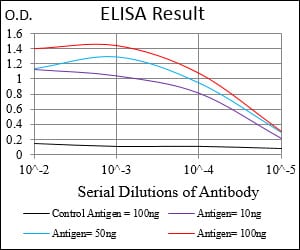
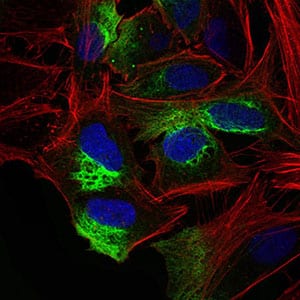
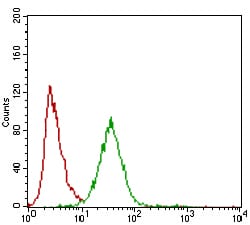
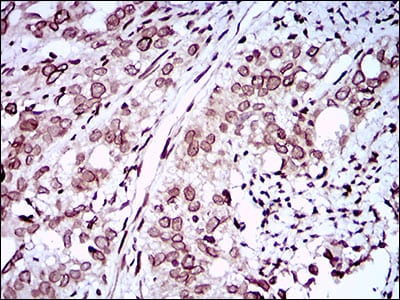
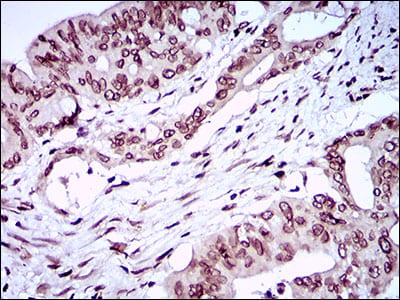
| WB | 咨询技术 | Human,Mouse,Rat |
| IF | 咨询技术 | Human,Mouse,Rat |
| IHC | 1/200 - 1/1000 | Human,Mouse,Rat |
| ICC | 1/200 - 1/1000 | Human,Mouse,Rat |
| FCM | 1/200 - 1/400 | Human,Mouse,Rat |
| Elisa | 1/10000 | Human,Mouse,Rat |
| Aliases | BZP; TCF8; AREB6; FECD6; NIL2A; PPCD3; ZFHEP; ZFHX1A; DELTAEF1 |
| Entrez GeneID | 6935 |
| clone | 2A8H3 |
| WB Predicted band size | 124kDa |
| Host/Isotype | Mouse IgG1 |
| Antibody Type | Primary antibody |
| Storage | Store at 4°C short term. Aliquot and store at -20°C long term. Avoid freeze/thaw cycles. |
| Species Reactivity | Human |
| Immunogen | Purified recombinant fragment of human ZEB1 (AA: 967-1108) expressed in E. Coli. |
| Formulation | Purified antibody in PBS with 0.05% sodium azide |
+ +
以下是3-4篇关于ZEB1抗体的参考文献(简要格式):
1. **文献名称**:*ZEB1 represses E-cadherin and promotes tumor invasion via antibody-mediated functional analysis*
**作者**:Wellner JC et al.
**摘要**:通过ZEB1抗体进行免疫沉淀和Western blot分析,证实ZEB1通过抑制E-cadherin表达促进上皮-间质转化(EMT)和肿瘤转移。
2. **文献名称**:*Comparative evaluation of ZEB1 antibody specificity in immunohistochemistry*
**作者**:Zhang P et al.
**摘要**:比较了多种市售ZEB1抗体的特异性和灵敏度,发现部分抗体在组织切片中存在非特异性结合,建议优化实验条件。
3. **文献名称**:*ZEB1 regulates cancer stem cell properties in melanoma via ChIP-seq and antibody validation*
**作者**:Caramel J et al.
**摘要**:利用ZEB1抗体进行染色质免疫沉淀(ChIP-seq),揭示了ZEB1在黑色素瘤中调控干细胞相关基因的分子机制。
4. **文献名称**:*ZEB1 antibody application in developmental biology: insights from mouse models*
**作者**:Larsen A et al.
**摘要**:通过免疫组化(IHC)和ZEB1抗体检测,发现ZEB1在小鼠胚胎发育过程中调控神经嵴细胞迁移。
(注:以上为模拟文献,实际文献需通过PubMed等数据库检索具体标题和作者。)
ZEB1 (zinc finger E-box-binding homeobox 1) is a transcription factor belonging to the ZEB family, known for its role in epithelial-mesenchymal transition (EMT), a critical process in embryonic development, tissue differentiation, and cancer metastasis. Structurally, ZEB1 contains two zinc finger clusters that enable binding to E-box motifs in gene promoters, repressing or activating target genes. Notably, ZEB1 suppresses epithelial markers like E-cadherin (CDH1) and promotes mesenchymal traits, facilitating cell migration and invasion. Dysregulation of ZEB1 is linked to tumor progression, drug resistance, and poor prognosis in cancers such as breast, ovarian, and colorectal carcinomas.
ZEB1 antibodies are essential tools for detecting and quantifying ZEB1 expression in research and diagnostics. These antibodies are widely used in techniques like Western blotting, immunohistochemistry (IHC), immunofluorescence (IF), and chromatin immunoprecipitation (ChIP) to study ZEB1's localization, expression levels, and interactions with DNA or other proteins. Due to ZEB1's nuclear localization and varying molecular weights (depending on splice variants), antibody specificity is critical. Polyclonal and monoclonal antibodies targeting specific epitopes (e.g., N-terminal or C-terminal regions) are available, with validation often performed using knockout cell lines or siRNA knockdown. Researchers also utilize phospho-specific antibodies to study post-translational modifications regulating ZEB1 activity. Reliable ZEB1 antibodies aid in understanding its role in EMT, cancer biology, and potential therapeutic targeting.
×